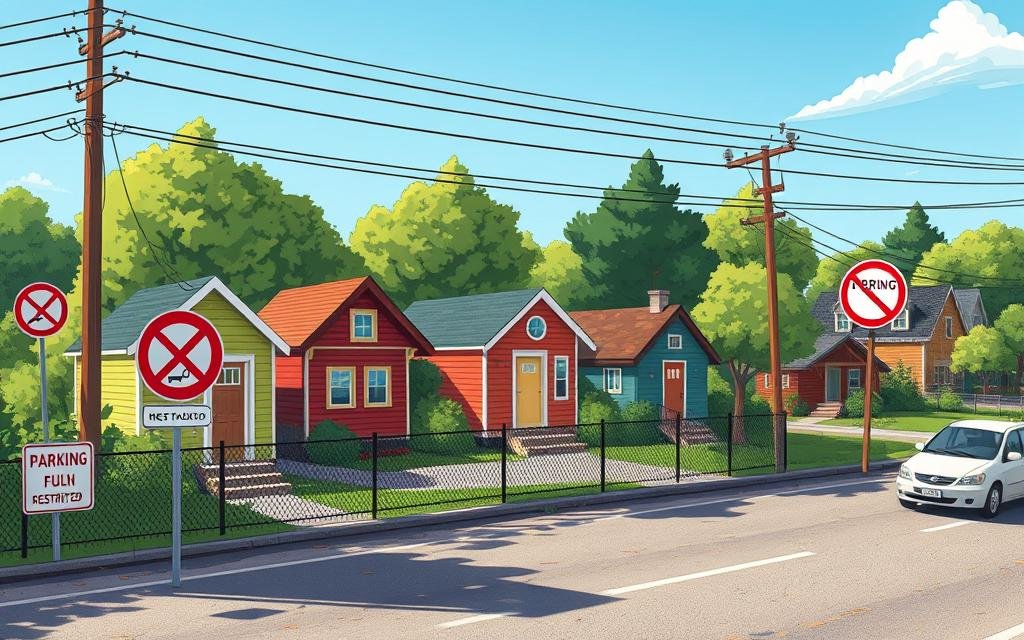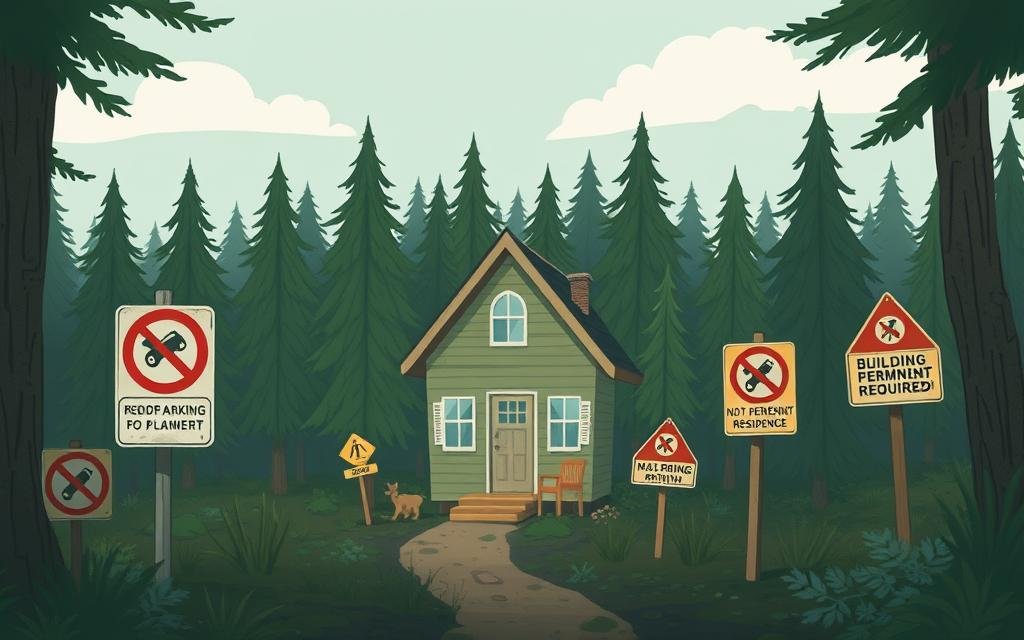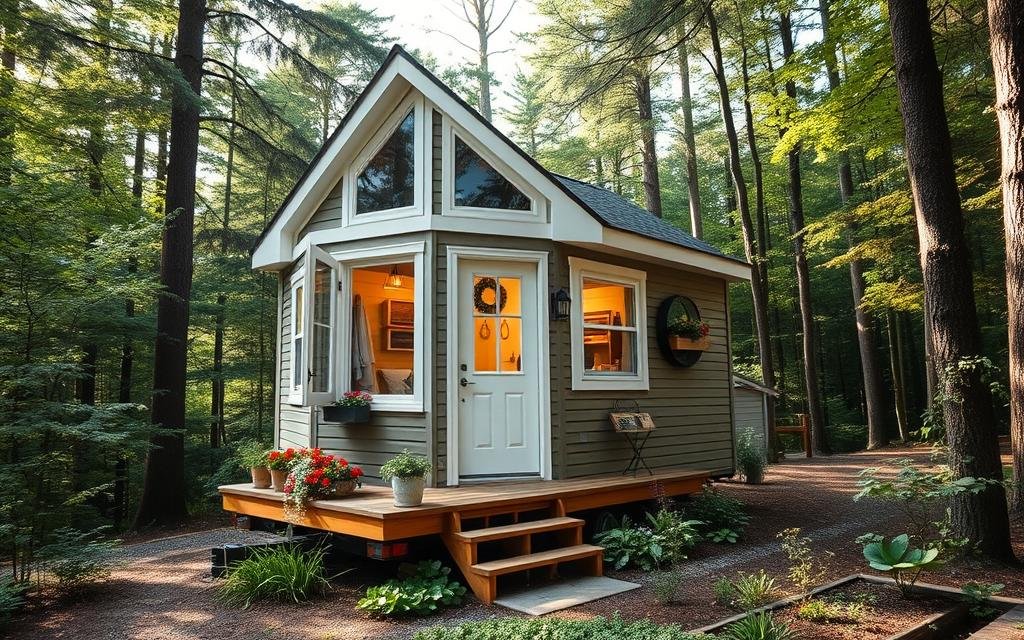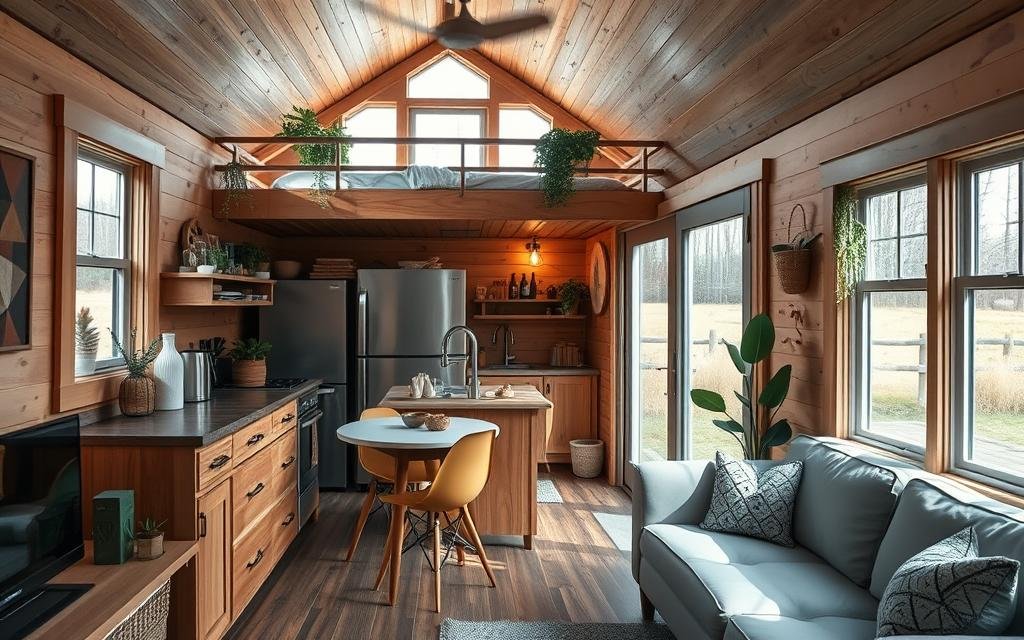Exploring tiny houses reveals that some states have strict zoning laws and building codes. These laws make it hard for tiny house owners to find a place to live. For example, New York and Rhode Island have rules that limit where tiny houses can go on residential properties1.
It’s clear that tiny house regulations and zoning laws differ a lot across the country. This affects which states are the worst for tiny houses.
Tiny homes are much smaller than regular houses, ranging from 100 to 400 square feet2. With a big need for affordable housing, tiny home communities are seen as a solution1. So, it’s important to understand the tiny house zoning laws.
Key Takeaways
- Some states have restrictive zoning laws and building codes that make it difficult for tiny house owners to find a place to live.
- Tiny house regulations and tiny house zoning laws vary significantly across the country.
- What states are the worst for tiny houses is determined by the specific laws and regulations in each state.
- Tiny homes can be classified as either permanent residences or recreational vehicles, complicating legislation2.
- Local zoning laws may impose minimum living space requirements per individual, affecting tiny house living2.
- Tiny house owners may need to adapt to living in smaller spaces, though quality tiny houses may maintain or appreciate in value over time2.
Understanding the Tiny House Movement’s State-by-State Challenges
More and more people are choosing tiny house living for its simplicity and sustainability. But, tiny house rules and building codes differ across states, limiting tiny house options. Tiny houses usually range from 100 to 400 square feet, which can be tough in states with strict codes3.
Some states treat tiny houses on wheels as recreational vehicles, with their own set of rules3. This makes it hard to find a place to park them. Also, some places have laws against tiny houses on wheels, limiting where they can be placed.
Despite these hurdles, many are drawn to the tiny house lifestyle for its focus on simplicity and sustainability. The movement is about living simply and intentionally, not just in a small space4. With careful planning and research, you can find a way to build a tiny house that fits local laws3.
Understanding the challenges and limitations of tiny houses helps us find more affordable and sustainable housing. Whether you’re already living in a tiny house or just curious, staying updated on local laws is key4.
What States are the Worst for Tiny Houses? Top Locations to Avoid
Thinking about tiny house living? You must check the tiny house regulations and tiny house zoning laws in each state. Some places are more welcoming to tiny houses than others. States like New York, Rhode Island, and Arkansas are tough due to strict zoning laws and building codes5.
Here are some of the worst states for tiny houses:
- New York: Tiny houses on wheels are seen as recreational vehicles, with their own set of rules5.
- Rhode Island: Laws here limit where tiny houses can go on residential land, making it hard to find a home5.
- Arkansas: The state’s building codes and zoning laws are very strict, making tiny house ownership tough5.
Knowing the tiny house regulations and zoning laws in each state is key. We suggest looking into the laws of the state you’re interested in. This way, you can own a tiny house without any problems6. Also, some states have rules about where tiny houses can be placed, like in mobile home parks or on private land7.

Restrictive Zoning Laws and Their Impact
We face many challenges with tiny house zoning laws and building codes. Some states don’t allow tiny houses on wheels or have size limits for homes8. Tiny homes are usually under 400 square feet8. This makes it hard for tiny house owners to find a place to live.
States like Arizona, California, and Florida are considered friendly to tiny houses8. But, some states have strict zoning rules, even if you own the land8. The cost of tiny homes varies, from $34,950 in New Hampshire to $74,917 in California9.
Here’s a quick look at some states and their tiny home costs and median incomes:
| State | Average Tiny-Home Cost | Median Income |
|---|---|---|
| Colorado | $43,192 | $77,172 |
| New Hampshire | $34,950 | $77,933 |
| California | $74,917 | $80,440 |
These numbers highlight the importance of considering costs and local laws when choosing a place for your tiny home9.
It’s crucial for tiny house owners to research local zoning laws and building codes. This ensures they can place their homes without problems8.
Building Code Complexities in Challenging States
Building tiny houses comes with many challenges. States have a lot of rules, with an average of 136,262 restrictions10. These rules can be tough to follow, affecting how and where you can build your home.
Some states, like California, have even more rules, with 403,774 restrictions10. This makes it hard for tiny house owners to meet all the requirements. But, states like Idaho have fewer rules, with only 36,61210, making it easier to build and modify homes.
It’s important for tiny house owners to understand these complex rules. This knowledge helps avoid costly mistakes and ensures homes are safe and follow local laws. By researching and understanding local regulations, owners can build homes that fit their needs and follow the law.

There are ways for tiny house owners to deal with these complex rules. They can start by looking into local regulations. They can also talk to experts, like architects and builders, who know about tiny house construction. Joining tiny house communities and online forums can also help, as owners can share their experiences.
Some important things to consider include:
- Researching local building codes and regulations
- Consulting with experts, such as architects and builders
- Joining tiny house communities and online forums
- Understanding the specific requirements for tiny houses in their area
By following these steps, tiny house owners can make sure their homes are safe and meet their needs. This is true even with the challenges of tiny house building codes and community restrictions10.
Urban vs Rural Restrictions for Tiny Houses
Urban and rural areas have different rules for tiny houses. Some states have strict laws against tiny houses in cities or need special permits for country homes11. Vermont is great for tiny house living, scoring 89.07, making it perfect for tiny house owners12.
In cities, tiny house owners face limits due to tiny house zoning laws and tiny house building codes. These rules can limit the size and type of tiny houses. But, in the countryside, there might be fewer rules, but you still need special permits or follow certain rules. On average, tiny houses are about 225 square feet, much smaller than regular homes11.
Here are some key things to think about for tiny house owners in cities and the countryside:
- Urban areas: tiny house community restrictions and tiny house zoning laws may limit the size and type of tiny houses allowed.
- Rural areas: special permits or guidelines may be required, but there may be more freedom to build and customize tiny houses.

So, tiny house owners need to research and understand the tiny house building codes and tiny house zoning laws in their area. This ensures they follow the rules and avoid problems12.
| State | Overall Score | Tiny House Legality Score |
|---|---|---|
| Vermont | 89.07 | 3 |
| Kentucky | 85.34 | 3 |
| Arkansas | 84.60 | 3 |
Legal Framework and Compliance Issues
Exploring the world of tiny houses reveals a complex legal landscape. Tiny house regulations, zoning laws, and building codes differ greatly by state13. For example, some places demand tiny houses follow the same building standards as regular homes. This can be costly and challenging for tiny house owners14.
One major hurdle for tiny house dwellers is dealing with zoning laws. These laws can be strict, limiting the materials and designs allowed15. It’s vital to research and grasp the specific rules in your area. This ensures your tiny house complies with local laws and regulations.
Some states aim to ease the process by exempting tiny houses under 120 square feet from permanent dwelling status14. Yet, it’s crucial to consult with local authorities and experts. This way, you can confirm your tiny house meets all requirements. Knowing the legal framework helps tiny house owners avoid problems and enjoy their lifestyle.

| State | Tiny House Regulations | Tiny House Zoning Laws |
|---|---|---|
| California | Must meet building codes | Restrictive zoning laws |
| Florida | Must meet building codes | Less restrictive zoning laws |
| New York | Must meet building codes | Restrictive zoning laws |
Community and HOA Restrictions
When looking at tiny house community rules, zoning laws, and building codes, there’s a lot to think about. Many homeowner associations (HOAs) don’t allow trailers and RVs, but not all16. About 30% of Americans live in HOA areas, with over 75 million people there17. This can make it hard for tiny house owners to find a place, mainly if they want a community with certain features.
Some states have laws against tiny houses in certain areas or need special permits for HOA-approved spots16. For example, some places don’t allow tiny houses on wheels, making it tough to find a home. Also, some HOAs have rules about materials or designs, which can be a problem for tiny house owners. The cost of following these rules can vary a lot by city, making it hard to guess the exact cost18.
It’s key for tiny house owners to check the community and HOA rules before buying. They should look into the laws in their area and make sure their tiny house fits all the rules. This way, they can avoid problems and find a community that welcomes tiny house living. Most cities let Tiny Houses as “accessory dwelling units” (ADUs)18, and some states are making Tiny Houses on wheels (THOWs) legal18.

In short, tiny house community rules, zoning laws, and building codes are important when looking for a place to live. By understanding these rules and doing research, tiny house owners can find a community that fits their lifestyle. There are many resources, like the Tiny House Industry Association (THIA), to help tiny house owners with these rules18.
Alternative Solutions and Workarounds
Exploring alternative solutions is key when dealing with tiny house regulations and building codes. Some states let tiny house owners call their homes RVs, offering more freedom19. This can help avoid strict rules and zoning laws.
Looking into tiny house communities is another option. These communities often have their own rules, which might be more relaxed than local laws20. Also, some cities offer incentives for building Accessory Dwelling Units (ADUs), like forgivable loans, making tiny houses more available20.
Seattle is a great example of a successful tiny house village. Residents stay for about four to five months, and 34% have moved into permanent housing20. Cities like Los Angeles, Milwaukee, and Denver are also setting up their own tiny house villages, with city funding and oversight20. These alternatives offer more freedom and ways to follow tiny house regulations and codes19.
It’s important for tiny house owners to know the local zoning laws and building codes. This ensures their home meets local standards and avoids problems19.
| City | Tiny House Initiatives |
|---|---|
| Seattle | 10 tiny house villages, with an average stay of 4-5 months |
| Los Angeles | Forgivable loans for ADUs, up to $75,000 |
| Milwaukee | Establishing tiny house villages, funded and monitored by the city |
Conclusion: Navigating the Future of Tiny House Living
The future of tiny house living looks promising, but we face many challenges. Some states have strict zoning laws that make it hard for tiny house owners to find a home21. Yet, the tiny home market is expected to grow by $5.8 billion from 2020 to 202421. Also, 56% of Americans are open to living in a tiny home, according to a survey by IPX 103121.
We can make a difference by understanding the needs of tiny house residents22. The 2018 International Residential Code defines a tiny home as one under 400 square feet, not counting lofts22. Tiny home villages can hold up to 350 homes, with plans to add more in different places22. By pushing for policy changes and talking to local governments, we can make tiny house living more accepted and appealing.



